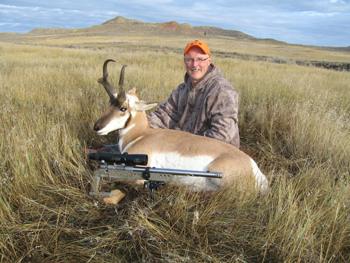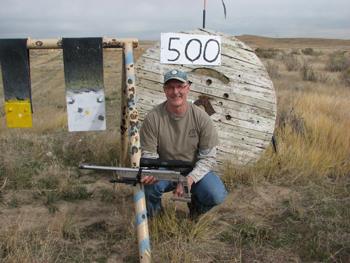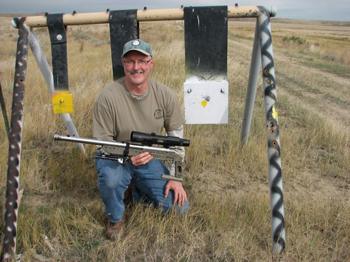Burris Eliminator Laserscope Review - 2
Some Observations about the Burris Eliminator:
When zeroing at 100 yards, I thought that the design of the main crosshair would hinder me from good accuracy. Not so. My last two shots at 100 yards were an elongated hole.

The turrets are ¼" per click per 100 yards. Since they were not intended to be used from shot to shot, they are not what I would want if I was going to be "dialing" but they are sufficient to the task for which the scope was designed.
You can zero your turrets by rotating the plastic indicator that is on the turret housing.
One area where I am prone to make a mistake when using this optic is that I typically dial for wind correction on long shots. Holding-off is something I used to do for wind compensation, but am out of the habit. When the pressure is on, you will likely fall back into old patterns.
For those who are just getting into long-range hunting and shooting, the Eliminator will be an easy switch since that is how many correct for wind to begin with. You need to know how far your bullet will drift at the distances you will be shooting, and you will also need a means to determine the speed of the wind.
The reticle of the Eliminator is in second focal plane. You must have the magnification on 12X for the electronic dots to be correct. It will range at any magnification, but the electronic aiming points coming down the vertical crosshair will be incorrect if it is not on 12x. If you turned the magnification down to 4x hunt in heavy cover, only to pop out in a meadow and see a bull on the far side, and forgot to turn the magnification ring to 12x, you will end up shooting high.

The glass is on par with many variable-powered scopes.
I did not use it in real low light, but it was sufficient for my uses.
I was pleasantly surprised at the level of precision I was able to achieve out to 600 yards when shooting steel targets. My hunting buddy Steve Hugel who also ran the camera, noticed that after my initial shot at 500 yards that subsequent rounds were ¼ MOA or closer to the bull at all distances out to 600 yards.
If you are using a flat-shooting rig your effective ability with the Eliminator may go out to 700 yards or so. I was ranging antelope just beyond 700 yards with no problem. The crosshair must be used when ranging game or a target. If your battery or electronics give out on you while hunting, it can still be used like any other traditional scope. If you developed a drop chart for your load and kept it with you, you could also dial your elevation if the electronics stopped working.

Eye relief was good enough on 12x for me to not be worried about getting "scope eye" when using a specialty pistol chambered in 7mm Winchester Short Magnum using 180 grain Berger's (mine has a good brake which also minimizes rearward motion).
Having a scope that will both determine range and give the correct firing solution will not make you a better shot or an instant long-range hunter. For hunters who want to increase their distance, and will practice their shooting skills from field positions (Get Off The Bench) will be able to increase their maximum range compared to using a plex or dot reticle.
It also automatically compensates for shooting angles up to 45 degrees. When the scope gets a distance reading that is beyond the capability of the reticle's drop compensation system, the bottom four dots will light up, signifying to you that the target is beyond the reticle's capability.
The Eliminator is a simple system which works well within its design parameters. If you are looking for an all-in-one system in terms of scope and laser rangefinder to extend shooting and hunting distances, the Burris Eliminator may just be the ticket for you.
Ernie Bishop resides in Gillette, Wyoming, where he serves as a preacher. He enjoys long range hunting for varmints and big game with handguns. Ernie also uses his specialty handguns in tactical style matches and in 1,000 yard competitions once or twice a year.
When zeroing at 100 yards, I thought that the design of the main crosshair would hinder me from good accuracy. Not so. My last two shots at 100 yards were an elongated hole.

The turrets are ¼" per click per 100 yards. Since they were not intended to be used from shot to shot, they are not what I would want if I was going to be "dialing" but they are sufficient to the task for which the scope was designed.
You can zero your turrets by rotating the plastic indicator that is on the turret housing.
One area where I am prone to make a mistake when using this optic is that I typically dial for wind correction on long shots. Holding-off is something I used to do for wind compensation, but am out of the habit. When the pressure is on, you will likely fall back into old patterns.
For those who are just getting into long-range hunting and shooting, the Eliminator will be an easy switch since that is how many correct for wind to begin with. You need to know how far your bullet will drift at the distances you will be shooting, and you will also need a means to determine the speed of the wind.
The reticle of the Eliminator is in second focal plane. You must have the magnification on 12X for the electronic dots to be correct. It will range at any magnification, but the electronic aiming points coming down the vertical crosshair will be incorrect if it is not on 12x. If you turned the magnification down to 4x hunt in heavy cover, only to pop out in a meadow and see a bull on the far side, and forgot to turn the magnification ring to 12x, you will end up shooting high.

The glass is on par with many variable-powered scopes.
I did not use it in real low light, but it was sufficient for my uses.
I was pleasantly surprised at the level of precision I was able to achieve out to 600 yards when shooting steel targets. My hunting buddy Steve Hugel who also ran the camera, noticed that after my initial shot at 500 yards that subsequent rounds were ¼ MOA or closer to the bull at all distances out to 600 yards.
If you are using a flat-shooting rig your effective ability with the Eliminator may go out to 700 yards or so. I was ranging antelope just beyond 700 yards with no problem. The crosshair must be used when ranging game or a target. If your battery or electronics give out on you while hunting, it can still be used like any other traditional scope. If you developed a drop chart for your load and kept it with you, you could also dial your elevation if the electronics stopped working.

Eye relief was good enough on 12x for me to not be worried about getting "scope eye" when using a specialty pistol chambered in 7mm Winchester Short Magnum using 180 grain Berger's (mine has a good brake which also minimizes rearward motion).
Having a scope that will both determine range and give the correct firing solution will not make you a better shot or an instant long-range hunter. For hunters who want to increase their distance, and will practice their shooting skills from field positions (Get Off The Bench) will be able to increase their maximum range compared to using a plex or dot reticle.
It also automatically compensates for shooting angles up to 45 degrees. When the scope gets a distance reading that is beyond the capability of the reticle's drop compensation system, the bottom four dots will light up, signifying to you that the target is beyond the reticle's capability.
The Eliminator is a simple system which works well within its design parameters. If you are looking for an all-in-one system in terms of scope and laser rangefinder to extend shooting and hunting distances, the Burris Eliminator may just be the ticket for you.
Ernie Bishop resides in Gillette, Wyoming, where he serves as a preacher. He enjoys long range hunting for varmints and big game with handguns. Ernie also uses his specialty handguns in tactical style matches and in 1,000 yard competitions once or twice a year.
